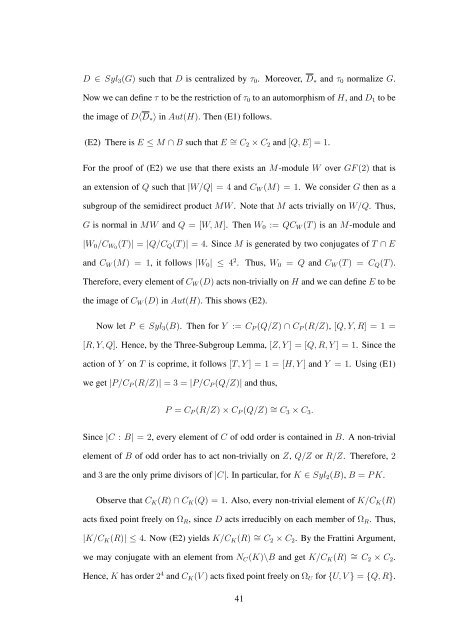SATURATED FUSION SYSTEMS OF ESSENTIAL RANK 1
SATURATED FUSION SYSTEMS OF ESSENTIAL RANK 1
SATURATED FUSION SYSTEMS OF ESSENTIAL RANK 1
Create successful ePaper yourself
Turn your PDF publications into a flip-book with our unique Google optimized e-Paper software.
D ∈ Syl3(G) such that D is centralized by τ0. Moreover, D∗ and τ0 normalize G.<br />
Now we can define τ to be the restriction of τ0 to an automorphism of H, and D1 to be<br />
the image of D〈D∗〉 in Aut(H). Then (E1) follows.<br />
(E2) There is E ≤ M ∩ B such that E ∼ = C2 × C2 and [Q, E] = 1.<br />
For the proof of (E2) we use that there exists an M-module W over GF (2) that is<br />
an extension of Q such that |W/Q| = 4 and CW (M) = 1. We consider G then as a<br />
subgroup of the semidirect product MW . Note that M acts trivially on W/Q. Thus,<br />
G is normal in MW and Q = [W, M]. Then W0 := QCW (T ) is an M-module and<br />
|W0/CW0(T )| = |Q/CQ(T )| = 4. Since M is generated by two conjugates of T ∩ E<br />
and CW (M) = 1, it follows |W0| ≤ 4 2 . Thus, W0 = Q and CW (T ) = CQ(T ).<br />
Therefore, every element of CW (D) acts non-trivially on H and we can define E to be<br />
the image of CW (D) in Aut(H). This shows (E2).<br />
Now let P ∈ Syl3(B). Then for Y := CP (Q/Z) ∩ CP (R/Z), [Q, Y, R] = 1 =<br />
[R, Y, Q]. Hence, by the Three-Subgroup Lemma, [Z, Y ] = [Q, R, Y ] = 1. Since the<br />
action of Y on T is coprime, it follows [T, Y ] = 1 = [H, Y ] and Y = 1. Using (E1)<br />
we get |P/CP (R/Z)| = 3 = |P/CP (Q/Z)| and thus,<br />
P = CP (R/Z) × CP (Q/Z) ∼ = C3 × C3.<br />
Since |C : B| = 2, every element of C of odd order is contained in B. A non-trivial<br />
element of B of odd order has to act non-trivially on Z, Q/Z or R/Z. Therefore, 2<br />
and 3 are the only prime divisors of |C|. In particular, for K ∈ Syl2(B), B = P K.<br />
Observe that CK(R) ∩ CK(Q) = 1. Also, every non-trivial element of K/CK(R)<br />
acts fixed point freely on ΩR, since D acts irreducibly on each member of ΩR. Thus,<br />
|K/CK(R)| ≤ 4. Now (E2) yields K/CK(R) ∼ = C2 × C2. By the Frattini Argument,<br />
we may conjugate with an element from NC(K)\B and get K/CK(R) ∼ = C2 × C2.<br />
Hence, K has order 2 4 and CK(V ) acts fixed point freely on ΩU for {U, V } = {Q, R}.<br />
41

















